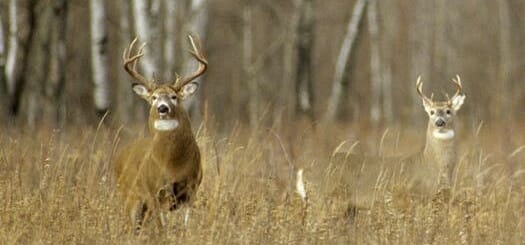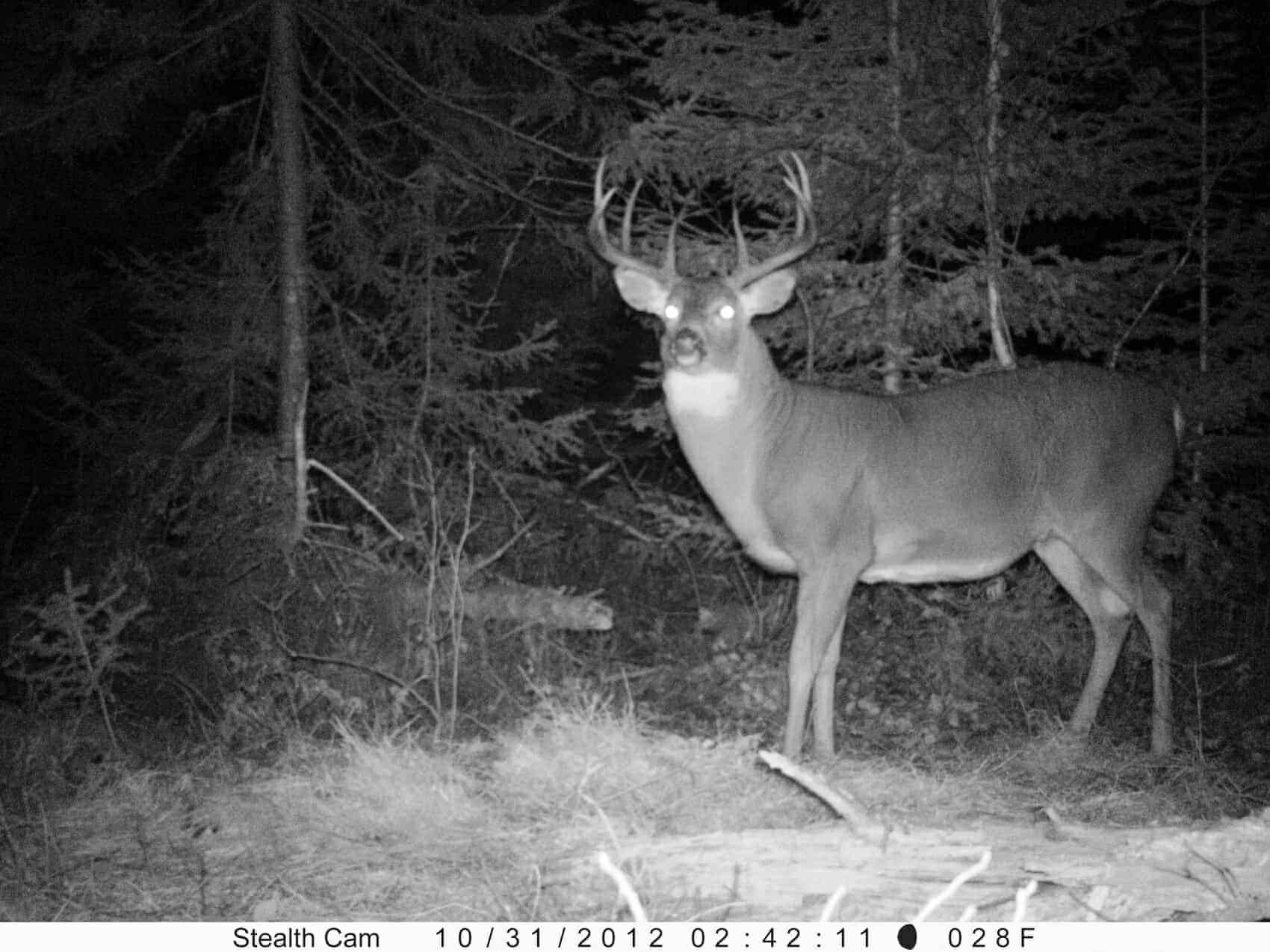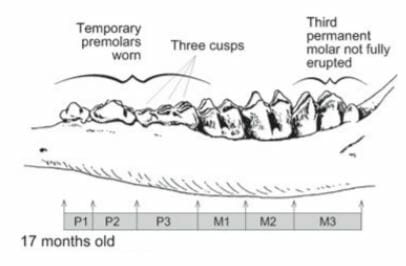Aging whitetail in the field can be an important aspect of your hunt. Trying to hold out for a mature buck has become an increasingly popular management strategy. Every single buck is different though. Many of their physical attributes can vary from deer to deer. This is why many hunters struggle to age deer correctly. Although, most anyone can tell a mature deer apart from a yearling, let’s dive into how to judge the middle stages.
What Do We Use to Judge Age?
To quickly judge the age of a deer in the field we can use four major attributes, the body/estimated weight of a deer, the belly and how low it hangs, how thick the neck is, and lastly if the antlers are spread outside the ears or not. It is recommended to not look at the antlers themselves to determine the age, focus mainly on the body. The bigger the neck, lower the belly, the older the deer. Make sure to follow through on your estimate after the shot with a jaw bone method (seen below).

Choosing the Right Picture on Cam
If you are not in the field and are judging bucks off of a trail camera picture, it is very important to choose the right pictures and not just ONE picture. You need pictures where you can clearly see all the physical features of the buck. We will use his features to judge him and choosing a picture with a bad angle or shadows can complicate the aging process. The QDMA ( Quality Deer Management Association) posted this picture to show the ideal stance for aging whitetail.

The Body
When judging the age of a deer you really should act like they have no antlers at all, and just focus on the body. If you look at a young deer you can really see just how slender they are. They are very sleek and skinny looking, deer take a few years to fill out. Just like humans, you can see the difference in the weight and muscle mass between a 13-year-old boy and a 25-year-old man.
Year after year deer start to pack on the pounds, so it is not unusual to see a super skinny young deer. When you see a mature deer, around 4 1/2, there will be no doubt that you know he is a mature buck just by how big his body is. A mature buck that is over 200lbs will appear to have short legs with his belly hanging down. His neck will look short and fat.
The Belly

If whitetail have good available nutrition, over the years they will pack on the pounds. Fatter deer are more likely to be older. Just looking at the belly you can tell a young deer from a mature deer quite easily. Young deer will have level bellies or even curved upward. While a mature deer will have a lower or even hanging belly, the lower the better. This causes old deer to appear short or stubby.
The Neck

The neck is one of the first things to look at when aging a buck. Combined with the muscle on the shoulders, the size of the neck can be a good sign of age. How swollen a buck’s neck is can also change with the season. During the rut, the neck swells up to show dominance. Around age 4 1/2 a bucks neck and shoulder muscles have fully developed and will appear to be short and thick. While in young deer the neck appears sleek and slender.
What to Expect at Each Age
1 1/2 Year Old Whitetail Deer
At this age, bucks are just starting to grow their first set of antlers and are probably the easiest deer to age. They are long and lanky and look like they are all legs. They are very slim with a small waist. These deer have a distinct line of separation between their neck and shoulders with little muscle definition. Most of the little weight they do have will be shifted towards the back of the deer. They will also have very light staining of the tarsal glands. At this age, if you were to strip away their antlers it would be difficult to tell a yearling buck apart from a doe.
Yearling bucks antlers are most likely small and are inside the width of the ears, but on well-managed properties, yearlings can be larger and have a respectable rack. That is why we try to disregard the antlers and focus on body features instead.
2 1/2 Year Old Whitetail Deer
These bucks are still slender looking with a thin waist. They have developed some muscle in their shoulders along with a little swelling in the neck but not very much. Their belly will still make a straight line and will not hang down. Most of their weight is still in their back half. With good nutrition, their antlers can be as wide or slightly wider than their ears. They likely have small mass but should be showing the framework of how their rack will look in years to come. These bucks can have moderate staining in their tarsal glands during the rut, especially if only a few mature bucks are in the population.
3 1/2 Year Old Whitetail Deer
For these bucks, their legs are finally the right length and they have built some muscle in the shoulders and torso. These bucks are still somewhat lean but are also built, so they are small and fast while also being big and strong. These bucks are close to their prime and have a lot of testosterone flowing and tend to have a badass teenager attitude which a lot of the time gets them killed. Their belly is still straight and they still have a defining line separating their neck and shoulders. Many of these bucks are starting to develop a very nice set of antlers. They should be outside the ears and starting to accrue a nice amount of mass. According to the QDMA, “most bucks have achieved 50 to 75 percent of their antler-growth potential” by this stage.
This is the average age a buck makes it to in the wild. Most unmanaged properties (especially public lands) do not have many bucks past this age. This is mainly due to their hormones and attitudes at this stage. It is bucks like these that can teach you about the trouble that chasing women can make.
4 1/2 Year Old Whitetail Deer
After 3 1/2 it gets much harder to tell the exact age in the field, but it is still very possible. 4 1/2 is the age most management systems believe that hunters should harvest bucks. At this age, bucks are very developed throughout the body and they are in their prime. Their legs now appear to short for their bodies. The bucks shoulders are filled out, their neck is much bigger and swells during the rut due to increased testosterone levels. You can no longer see a defined line between the neck and brisket, they are now one mass. Their belly will not hang by much but they will not be completely flat. Now you can see significant staining on the tarsal glands as well.
According to RealTree “By this time in their life, bucks will display 80 to 90 percent of their antler’s potential”. Bucks by now have large antlers and a large amount of mass. Bucks in this age range account for many of the trophies taken.
5 1/2 – 6 1/2 Year Old Whitetail Deer
Bucks rarely get past 5 years old in free range areas. These bucks are as big as they are going to get and if you are lucky enough to take a buck that makes it to this age you will be able to immediately tell that this is a mature deer. Deer at this age regardless of antler size are a true trophy, these bucks have been around the block a time or two and have most likely outsmarted or barely escaped a hunter before. If you have ever heard of the term “roman nose” these are the bucks they are talking about. The bucks nose begins to round off as he gets older and looks less pointy like a doe.
Now their bellies are starting to sag, the back may even sway down. The chest is deeper and larger, and the brisket may sag as low as the stomach line. The neck is extremely large and swollen. The legs appear very short compared to the rest of the body and there is very heavy staining on the tarsal glands.
7 1/2 – 8 1/2 Year Old Whitetail Deer
You can think of these deer as the elderly old men of the deer world. For deer to be this old is very rare. These deer are on the decline and are losing weight. Their antlers will start to get smaller and they will become less active and probably will not chase does, and if they do, they will not chase as hard as a younger buck. A chin flap may also be present as the deer shrinks from its former size.
To help you remember all these rules The QDMA has a poster with examples for aging whitetail that you can get here from Amazon.
The Follow-Up | Aging Whitetail by Teeth
It is very important to check your age estimates after you take the shot. This way you can audit your own whitetail aging performance and better manage your property.

Where Do You Start?
Aging whitetail by the teeth is a game of elimination. The whole concept is that if this jaw passes certain criteria then it must be older than X amount of years. We will use two processes in this technique, tooth replacement, and tooth wear. during these processes, we will use the number of adult teeth coupled with the amount of wear on the molars to get an accurate estimate of the deers’ age.
Tooth Replacement
Just like humans, a whitetail has baby teeth that fall out and get replaced periodically. An adult whitetail has six teeth on each jaw, three premolars, and three molars. These are the teeth we will be looking at to assess age. Using this method we can quickly tell the difference between a fawn, a 1 1/2-year-old, and a 2 1/2 & older whitetail.
Fawn
Judging a fawn is the common sense first step to whitetail aging. Deer are born with three temporary teeth and one molar. The other two teeth are soon to come around the age of 1 1/2. So easily enough, if a jaw has less than six teeth it is a fawn.
1 1/2 Year Old Whitetail Deer
A 1 1/2 deer has grown six molars on each side. You can tell a jaw belongs to a 1 1/2-year-old deer is by his third premolar. The third premolar will still be a baby tooth and have three cusps to it. if you can verify that it has three cusps, you can confirm it is a 1 1/2-year-old whitetail.

2 1/2 Year Old Whitetail Deer
Much like the last strategy, check that the jaw has six teeth. Then go to the third premolar and check if it only has two cusps. If your deer only has two cusps on his third premolar you can confirm the whitetail is at least 2 1/2 years old.
To get a visual representation of this information the QDMA has some really good videos on this topic.
Tooth Wear
Using the tooth wear method you can tell the difference between 3 1/2-year-old deer all the way up to 6 + years old. This technique looks at the enamel(white outer layer) and dentine(dark inner layer) of the whitetails fourth molar to start. We use the fourth molar in this case because it is the oldest tooth the deer has. The main question we will be asking is how wide is the dentine strip on the TOP of the crest compared to the outer layer of enamel. This method is one of the most accurate for aging whitetail deer.
2 1/2 Year Old Whitetail Deer
If we have concluded that a deer is at least 2 1/2 using the tooth replacement strategy, we can now look at the wear of the fourth molar to confirm it is 2 1/2 and not older. We can see an inner strip of dark dentine and we can ask the question, is the inner strip on dentine twice as thick as the outer strip of enamel? If the answer is no, then your whitetail is 2 1/2 years old.
3 1/2 Year Old Whitetail Deer
Using the same strategy on the fourth molar, we can ask is the dentine or dark material twice as thick as the outer layer of enamel? If the answer is yes, the deer is at least 3 1/2 years old. We then have to slide over to the fifth tooth and ask the same question again. If your answer is no then you can confirm your deer to be 3 1/2 years of age.
4 1/2 Year Old Whitetail Deer
Now we are on the fifth molar, asking is the strip of dark dentine on the top of the cusp twice as thick as the enamel next to it? If your answer is yes, then the deer is at least 4 1/2 year old. Now we go to the sixth and last tooth. We ask the same question and if your answer is no, then you can confirm your deer to be 4 1/2 years of age.
5 1/2 Year Old Whitetail Deer
If you get to the last molar and ask the same question, Is the dentine twice as wide as a strip of enamel, and your answer is yes, then the animal is at least 5 1/2 years old.
6 1/2 + Year Old Whitetail Deer
After your deer jaw has passed all the criteria to be at least 5 1/2 years old, we can start looking at the fourth molar again. We then ask a new question. Is the fourth tooth beginning to flatten out or dish? if the answer is yes, then the whitetail is at least 6 1/2 years old.
After 6 1/2 this method loses its reliability, and aging up to 6 1/2 is adequate for most management strategies. However, any deer that is 6 1/2 years of age or older, regardless of antler size is a true trophy that anyone would be proud of.
Conclusion
Knowing what to look for when aging whitetail is very important. As with all skills, practice makes perfect. So practice with reliable sources online but also after you down a deer. Using the teeth method of aging whitetail can be much more accurate. All and all using this skill sets you on your way to becoming a better hunter.
Thanks for reading my article about how to age whitetail deer. I hope you enjoyed it and learned something you didn’t already know. If you like my content, subscribe to my weekly update. If you have any other questions about strategies for aging whitetail deer or just want to connect, feel free to email me at Patrick.Long@omegaoutdoors.net.
